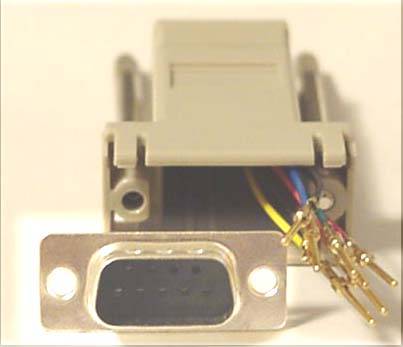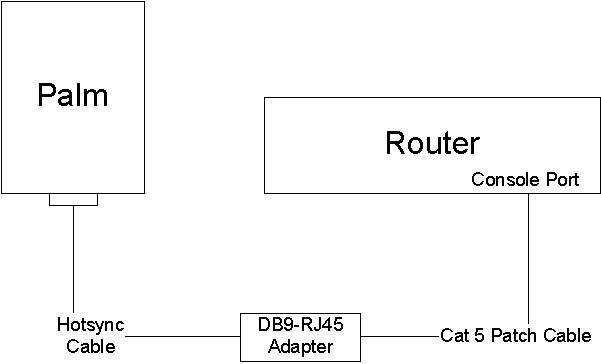
By: Christopher
Phillips
Date: February 6, 2001
This is for you technicians out
there who have ever needed a quick and dirty way to physically
connect to a Cisco router or other piece of communications
equipment. Many people don’t know you can
use your Palm as a VT100 emulator. With
a free software program and a couple of cables you can forget about
lugging that laptop around to make a console connection to your
equipment.
· The
first thing you need to do is load the emulator on your Palm. I
use Ptelnet, which is a freeware program you can download at ptelnet-06.zip
, or at http://netpage.uai.com.br/mmand
There are other programs out there, but for basic VT100
emulation
I think this one performs the best.
· You will also need a hotsync cable. You can use your hotsync cradle, but it is awkward and not nearly as portable.
· Next you will need a short Cat-5 patch cable, straight through, with an RJ-45 head on each end.
· The last item is an RJ-45 to DB9(male) adapter. Unfortunately, you cannot purchase this with the proper pinout, so you will have to purchase an adapter kit (see picture below) and insert the pins as described later in this document. Now don’t let this scare you off. The kit costs less than 1 dollar, can be purchased at any electronic supply store and can be assembled in less than 5 minutes. The only tool you will need is a pair of needle nose pliers and even those are not absolutely required.

Here is the pinout for the adapter. The RJ-45 end will already be connected, but you will need to insert the pins on the DB9 side in the following order. (Note: The holes on the DB9 piece are numbered)
1 – Red
2 – Yellow
3 – Black
4 – none
5 – Green
6 – Brown
7 – Blue
8 – White
9 – Orange
Once you have all the pins inserted in the proper hole, snap the adapter together.
Below is a picture of what this looks like when it is all put together. You connect one end of the hotsync cable to your Palm and the other to the DB9/RJ-45 adapter. Then you plug the Cat-5 cable in the other end of the DB9/RJ-45 adapter. Finally you plug the remaining end of the Cat-5 cable into the console port on the Cisco router or switch.

To establish the connection, start the Ptelnet application. You will need to configure Ptelnet first, so tap on the MENU icon and under OPTIONS, tap on SERIAL. Set your baud rate to 9600, Parity to “N”, Word to “8”, StopBits to “1” and check the box for Xon/Xoff. Make sure the box for RTS/CTS is not checked. Then tap on “OK”. You should only have to configure Ptelnet this first time.
To establish your session with the router/switch, tap the “On”
button at the bottom. Then draw the
graffiti symbol for “Enter” or carriage return. You
should see receive a prompt from your router/switch and you are
ready to go.
I have successfully used this combination to communicate with
Cisco routers and switches, Cabletron hubs, 3Com switches (only
the hotsync cable is required for this), and Motorola Vanguard
routers. I have also shared this with
other technicians in my shop and they have used this
successfully. I have never had this cause
any problems with any of these devices. If
you want to use this to connect to a device that is not listed here,
then try it. With a little
experimentation, you should be able to connect to anything that has an
RJ45 port and supports VT100. However,
use this at your own risk! I don’t make
any guarantees that this will work or that it won’t cause your
equipment to blow up..
If you would like to add your own comments to this review or review a different product, please send a message to: kcpug@interpug.com